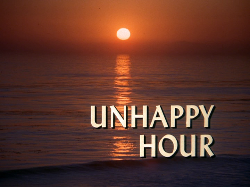Unhappy Hour (Quincy, M.E.)
| Unhappy Hour | ||||||||||||||||||||||||||||||||||||||
|---|---|---|---|---|---|---|---|---|---|---|---|---|---|---|---|---|---|---|---|---|---|---|---|---|---|---|---|---|---|---|---|---|---|---|---|---|---|---|

| ||||||||||||||||||||||||||||||||||||||
|
Episode Quote
"Sometimes the hardest truth is knowing the one you love may not have been the one driving." ~ Dr. Quincy, in Unhappy Hour (Quincy, M.E.)
Episode Overview
Unhappy Hour is the sixteenth episode of season five of Quincy, M.E., originally aired on NBC on February 14, 1980. Quincy is called to investigate a fatal car crash in which Dr. Asten's niece may have been the driver, raising questions of culpability and teenage alcohol use. :contentReference[oaicite:0]{index=0}
Table of Contents
Application of The QME Episode Laws
✅ **Law 1 – Truth & Justice:** Quincy investigates beyond the official verdict to uncover evidence that challenges assumptions about responsibility. :contentReference[oaicite:1]{index=1} ✅ **Law 2 – Social/Ethical Issues:** Tackles teen drinking, DUI laws, and family consequences, highlighting societal pressures. :contentReference[oaicite:2]{index=2} ✅ **Law 3 – Sensitive Topics:** Addresses guilt and youthful recklessness with nuance and emotional depth. :contentReference[oaicite:3]{index=3} ✅ **Law 4 – Scientific Accuracy:** Uses crash reconstruction and BAC toxicology to clarify who was driving and why. :contentReference[oaicite:4]{index=4}
Episode Synopsis
After a car accident kills a teenager, Dr. Asten’s niece Andrea is presumed to be the driver. Quincy’s autopsy and BAC testing reveal the victim's alcohol level and injuries. During reconstruction, Quincy determines Andrea may not have been driving at the time—pointing instead to the deceased friend. The revelation spares Andrea from legal prosecution and exposes broader issues of teen drinking and legal responsibility. :contentReference[oaicite:5]{index=5}
Plot Summary
- A crash scene with a single fatality raises suspicion that Andrea Asten was driving.
- Quincy conducts autopsy and BAC tests; results suggest both teens were drinking.
- Quincy and Sam reconstruct the accident using physical evidence and simulation.
- Discovery: skid patterns and impact timing indicate Andrea was a passenger.
- Quincy confronts the reality of teen drinking culture and notifies Dr. Asten.
- Andrea is cleared legally, and Quincy calls for education about teenage alcohol laws.
Main Cast
- **Jack Klugman** as Dr. R. Quincy
- **Robert Ito** as Sam Fujiyama
- **John S. Ragin** as Dr. Robert Asten
- **Garry Walberg** as Lt. Frank Monahan
- **Val Bisoglio** as Danny Tovo
- **Joseph Roman** as Sgt. Brill
Guest Cast
- **Madlyn Rhue** as Andrea Asten :contentReference[oaicite:6]{index=6}
- **Paul Lambert** as Wilson :contentReference[oaicite:7]{index=7}
- **Joseph Sirola** (uncredited) :contentReference[oaicite:8]{index=8}
- **Michael Flanagan** as Douglas (friend involved in crash) :contentReference[oaicite:9]{index=9}
Case File Summary
Victim: Teenage friend of Andrea Asten Case #: LACC S5E16
The evidence initially implies Andrea was driving under influence, but forensic reconstruction proves otherwise.
Additional Victims
- Single fatality; no further casualties.
Alleged Perpetrator
- Initially, Andrea Asten – ruled innocent by Quincy’s meticulous forensic work.
Filming Locations
Interior reconstructions filmed on studio sets; crash exterior communicated via staged footage.
Forensic Science Insight
- Blood alcohol analysis to assess impairment.
- Accident reconstruction comparing vehicle dynamics with injury patterns.
- Use of skid marks and passenger positions to establish the driver.
- Expert testimony to exonerate an innocent party, highlighting science's power to correct assumptions.
Themes & Tropes
- **Teen Alcohol Awareness** – uncovers dangers of underage drinking.
- **Parental Guilt** – Dr. Asten faces emotional conflict.
- **Forensic Redemption** – Quincy uses science to deliver justice.
Reception & Legacy
Critics and fans appreciated its emotional impact and educational value. Trakt users give a 7.4/10 rating. :contentReference[oaicite:10]{index=10} It has been recognized as a poignant “tear-jerker” and an early example of evidence-based exoneration on TV. :contentReference[oaicite:11]{index=11}
Trivia
- Featured a rare, emotionally tense scene where Quincy comforts Dr. Asten.
- Showed early use of crash reconstruction on television dramas to challenge courtroom assumptions. :contentReference[oaicite:12]{index=12}
Cultural Impact
Unhappy Hour contributed to the public conversation on teenage drinking and DUI, and the episode exemplified how forensic pathology can be leveraged to challenge punitive assumptions in the justice system.
